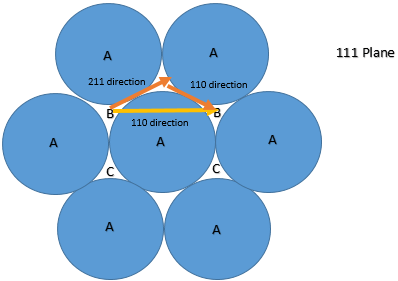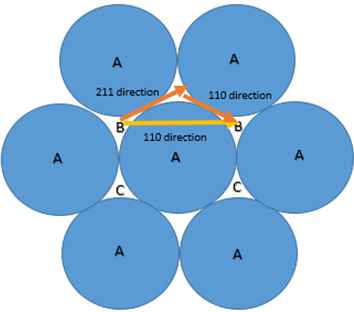This set of Mechanical Metallurgy Multiple Choice Questions & Answers (MCQs) focuses on “Dislocation in BCC, FCC & HCP”.
1. The burger vector for Face-centred cubic material is _______; Where ao is the lattice parameter.
a) ao/2[110]
b) ao/2[111]
c) ao[110]
d) ao[100]
View Answer
Explanation: Slip occurs in the FCC lattice on the {111} plane in the (110) direction. The shortest lattice vector is (a0/2) [110], which connects an atom at a cube corner with a neighbouring atom at the centre of a cube face. The Burgers vector is, therefore, (a0/2) [110].
2. The slip in FCC crystal occurs in the (111) plane in {110} direction, but generally it is not energetically favourable, so it slips into two partial dislocations. The correct partial dislocation is represented by which of the following equation?
a) ao/2[1 1 0] → ao/3[-1 2 1]+ao/2[112]
b) ao/2[1 1 0] → ao/6[-1 2 1]+ao/6[112]
c) ao/2[1 1 0] → ao/6[2 -1 -1]+ao/2[11-2]
d) ao[1 1 0] → ao/3[-1 2 1]+ao/2[112]
View Answer
Explanation: The close pack plane in FCC is (111). The stacking sequence is ABCABC. The vector b = (a0/2)[101] defines one of the observed slip directions. The two-step path b2 + b3 can accomplish the same shear displacement as produced by b1. The latter displacement is more energetically favourable, but it causes the perfect dislocation to decompose into two partial dislocations.

3. The formation of Shockley partial dislocation in the material will generate a region of stacking fault.
a) True
b) False
View Answer
Explanation: The Shockley partial dislocation is the reaction for dissociation of perfect dislocation into two partial dislocations in FCC material as shown in the figure:

The atoms in the slip plane migrate to position C instead of B, so it creates a fault in stacking sequence of the material from ABCABCABC to ABCA|CABC.
4. The higher the width of the stacking fault _________ will be the stacking-fault energy. Higher the stacking fault energy __________ will be the cross slip.
a) higher, easier
b) lower, easier
c) lower, difficult
d) higher, difficult
View Answer
Explanation: The greater the width of the stacking fault (lower the stacking-fault energy), the more difficult it is to produce constrictions in the stacking faults. This relationship explains why cross slip is quite prevalent in aluminium, which has a very narrow stacking-fault ribbon, while it is not observed usually in copper, which has a wide stacking-fault ribbon.
5. The burgers vector for frank partial dislocation is equal to ___________ (Lattice parameter is ao)
a) ao[100]
b) ao/2[110]
c) ao/3[111]
d) ao/3[110]
View Answer
Explanation: The partial dislocation can exist in the FCC on (111) lattice plane. An edge dislocation is formed in this region with a Burgers vector (a0/3) [111]. This is called a Frank partial dislocation. Its Burgers vector is perpendicular to the central stacking fault. Since glide must be restricted to the plane of the stacking fault and the Burgers vector is normal to this plane, the Frank partial dislocation cannot move by glide. For this reason, it Is called a sessile dislocation.
6. Shockley dislocation is which type of dislocation?
a) Sessile
b) Glissile
c) Full dislocation
d) Mixed dislocation
View Answer
Explanation: Dislocation which can move freely over the slip plane, is called glissile dislocation. Examples being perfect dislocation or Shockley dislocation.
7. The basal plane and chief slip direction for Hexagonal closed packed structure is _________
a) (0 0 0 1) & <1 1 2 0>
b) (0 2 1 1) & <1 1 -2 0>
c) (0 0 0 1) & <1 0 0 0>
d) (1 1 2 2) & <1 1 -2 1>
View Answer
Explanation: The basal plane of the hcp lattice is a close-packed plane with the stacking sequence ABABAB. Slip occurs on the basal plane (0001) in the <1 1 2 0>.
8. Burger vector for Hexagonal closed packed structure is ______
a) (a0/3)[1120]
b) (a0)[1120]
c) (a0/3)[1000]
d) (a0)[1000]
View Answer
Explanation: The smallest unit vector for the hcp structure has a length a0 and lies in the close-packed (1120) direction. Therefore, the Burgers vector is (a0/3)[1120].
9. The extended dislocation formed on the basal plane of Hexagonal closed packed structure are sessile dislocation.
a) True
b) False
View Answer
Explanation: Dislocations in the basal plane can reduce their energy by dissociating into Shockley partials according to the reaction.
(a0/3)[1 1 -2 0] → (a0/3)[1 0 -1 0] + (a0/3)[0 1 -1 0] The stacking fault produced by this reaction lies in the basal plane, and the extended dislocation which forms it is confined to glide in this plane.
10. The Burgers vector for Body-centred cubic lattice will be equal to ________
a) ao[100]
b) ao[110]
c) ao/2[111]
d) ao/2[110]
View Answer
Explanation: Slip plane in BCC are {110}, {112}, {123} but the slip direction is always (111), so the burger vector will be defined by (111) direction. The burger vector will be equal to ao/2[111]. Where ao is lattice parameter.
Sanfoundry Global Education & Learning Series – Mechanical Metallurgy.
To practice all areas of Mechanical Metallurgy, here is complete set of 1000+ Multiple Choice Questions and Answers.
If you find a mistake in question / option / answer, kindly take a screenshot and email to [email protected]
- Practice Metallurgical Engineering MCQs
- Check Metallurgical Engineering Books
- Apply for Metallurgical Engineering Internship
- Check Mechanical Metallurgy Books
